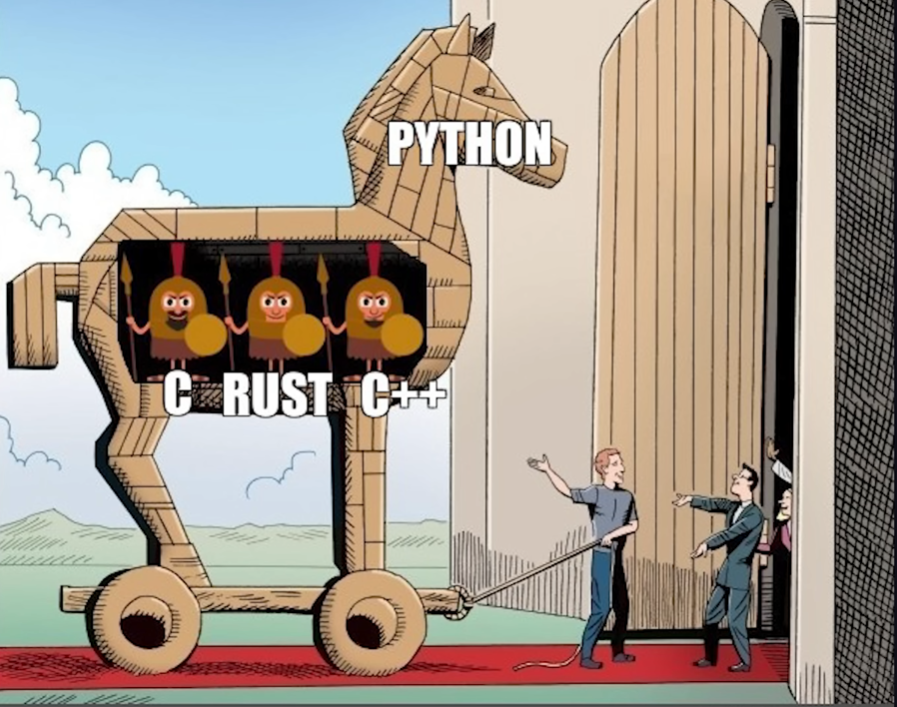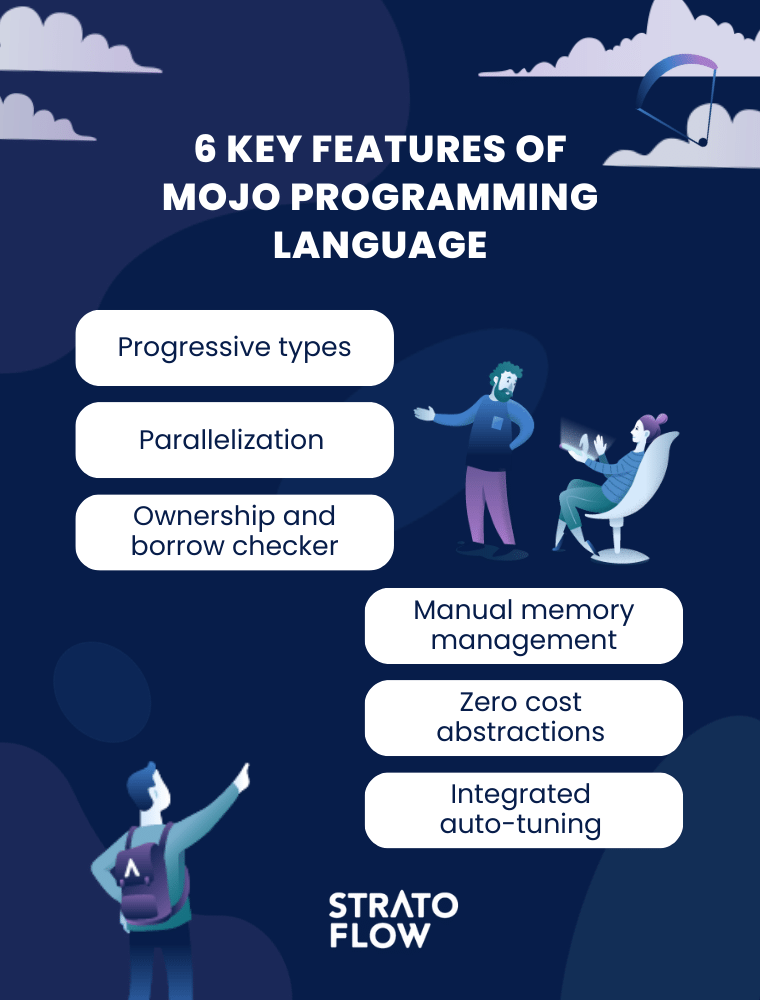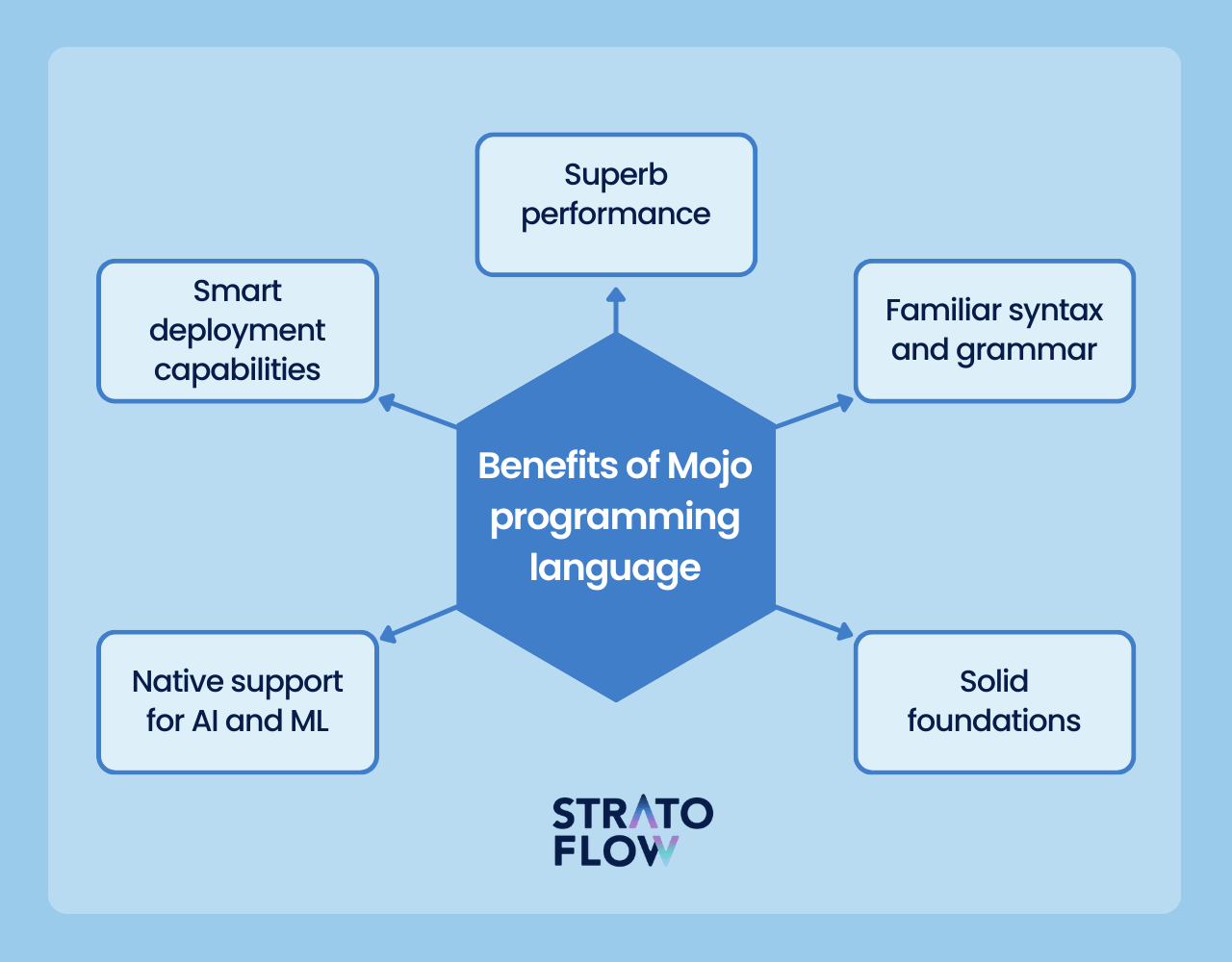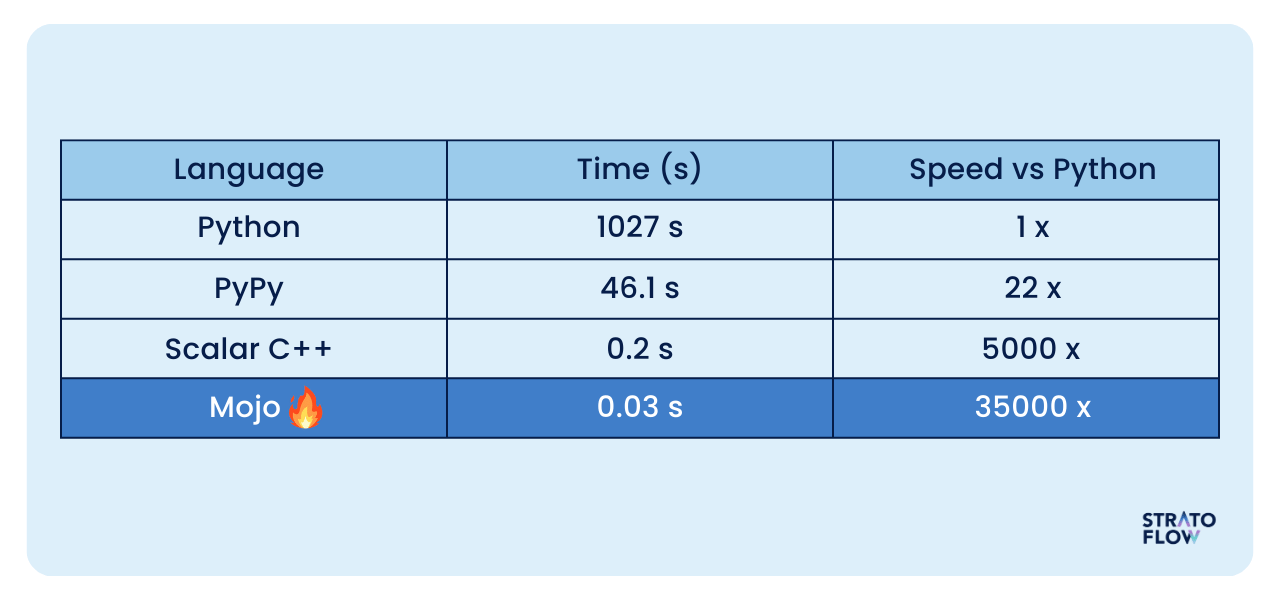
Introduction to Mojo Programming Language: New Era of AI Programming
When starting a new AI software development project, Python is an obvious language choice. After all, it offers great simplicity, readability, and a huge ecosystem of libraries and frameworks designed for machine learning and artificial intelligence.
What if I told you that there’s an interesting alternative on the market? Something that combines the ease of Python with the power of C?
Enter Mojo.
This brand new programming language is going to be a very interesting alternative to other programming languages, especially in development projects where software performance is a top priority. What is Mojo and what are its main selling points? Read on to find out!
What is Mojo?
Designed by Chris Lattner, the creator of the Swift programming language and the LLVM compiler, and developed by Modular, Mojo is a brand-new programming language that aims to bridge the research and production aspects of software development by combining Python syntax with systems programming and meta-programming capabilities.
Some say that Mojo is basically Python++ – a link between the great usability and accessibility of Python and the high performance of C.
When completed, Mojo will be a superset of Python, but it will also provide additional functionality so that software developers can write high-performance code that takes advantage of modern accelerators – something that is absolutely critical for the development of artificial intelligence and machine learning, enabling further AI transformation.
Python stands out from other languages for a variety of reasons.
For one, it is the first choice for enterprise data science and AI enterprise software projects because of its wide variety of rich libraries and frameworks. It also has an elegant and easy-to-understand core on which developers can build their software applications.
But it does have one serious drawback: performance.
According to recent studies, Python can be thousands of times slower than C++ or even Java in some situations.
However, Python has a neat trick up its sleeve: developers can call out pieces of code written in other, much faster languages. Thus, it is possible to avoid using Python to implement performance-critical parts and opt for solutions written in C, Rust, and C++. There are also smart libraries like Numpy and PyTorch that provide Python-like interfaces for high-performance code, making Python programmers feel right at home configuring such solutions.
But this multi-language approach also has some serious disadvantages.
For one thing, it is increasingly complex and difficult to profile, debug, and deploy. Many programming tools that Python programmers are familiar with will no longer work once we have to jump back and forth between different languages for performance-oriented backend implementation.
There’s also the problem of Python’s lack of effective parallel processing. Modern AI-focused hardware infrastructure often consists of high-performance computing cores, but Python will generally only use one at a time. Of course, there are some clumsy ways around this problem, but none are optimal.

Mojo, on the other hand, was built from the ground up as a language for developing artificial intelligence and machine learning applications.
As such, it comes with a wealth of Mojo functions and modules in the standard library for building neural networks, performing computer vision, and preparing data.
If you’re familiar with working with popular AI-focused Python libraries like NumPy and PyTorch, don’t worry! Mojo supports them as well. That’s the key benefit of building on top of an existing and rich language like Python.
What’s more, Mojo is designed to efficiently manipulate multiple values in parallel. This feature is critical for machine learning-a field that relies heavily on linear algebra. Mojo also compiles just-in-time, so the bytecode is further optimized for speed.
Another key advantage of Mojo for developing ML and AI solutions is its compatibility with more robust AI hardware. By leveraging Multi-Level Intermediate Representation (MLIR), it is possible to scale to different types of hardware, including GPUs running CUDA (or similar architectures), without adding unnecessary complexity.
[Read also: Benefits of Artificial Intelligence for Modern Businesses]
Features of Mojo
As we’ve mentioned before, while Mojo is considered a revolutionary programming language, it’s really just Python at its core.
Just as TypeScript is a superset of JavaScript, Mojo is a superset of Python – one of the most popular languages with millions of active programmers. So there is no need to learn a new programming language to get started.
Convenient, right?
All the major advantages and limitations of Python are already perfectly understood by virtually all programmers. Other relatively new programming languages like Rust and Zig don’t offer this luxury.
That said, let’s cover the key features of Mojo that make it a unique and advantageous choice for AI application development:

- Progressive types – Mojo leverages types for better performance and error checking,
- Parallelization – Mojo introduces MLIR, a novel approach to building reusable and extensible compiler infrastructure that enables mojo developers to scale to exotic hardware types. It lets software developers to take advantage of vectors, threads, and AI hardware units including GPUs running CUDA,
- Ownership and borrow checker – For memory management Mojo offers an ownership and borrow checker similar to Rust which ensures memory safety without introducing additional complications,
- Manual memory management – Similar to C++, Mojo offers manual memory management. It is thus a language that gives you safety but lets you be unsafe when needed.
- Zero cost abstractions – Mojo allows for taking control of storage by inline-allocating values into structures,
- Integrated auto-tuning – With autotuning, Mojo can automatically find the best values for your parameters for your specific hardware, which can drastically streamline the programming process and improve software performance.
[Read also: Can ChatGPT Write Code?]
Key advantages of Mojo programming language
We’ve already covered the main advantage of Mojo – its similarity to native Python code.
Now, let’s take a quick look at other features of Mojo that set it apart from other programming languages, especially when it comes to developing artificial intelligence software solutions:

Superb performance
The creators of Mojo had a simple goal in mind: to make a programming language as easy to use as Python, but as powerful and fast as C.
There are a number of tricks that Mojo offers to achieve much faster software performance compared to basic Python.
It introduces strong type checking, which is essential for optimized performance and error checking. It also includes an ownership and borrowing system that greatly improves memory management – another critical aspect of building high-performance applications.
In addition, Mojo programmers can use “struct” instead of “class”, and attributes are tightly packed in memory so that they can even be used in data structures without chasing pointers.
These are the kinds of features that allow languages like C to deliver top-notch performance, and now they’re available to Python programmers.
Taking all this into account, Mojo promises up to 35000 times faster software performance over standard Python. Crazy!

Smart deployment capabilities
A big problem with Python apps is deployment.
Currently, if you want to show your friend a program you wrote in Python, you have to tell them to install Python! As a compiled language, the Mojo code deployment approach is basically the same as C. If we take, for example, a version of Matmul written from scratch in Mojo, it is around 100k.
This is truly a game-changer!
In essence, this means that Mojo can be much more than just a language for AI/ML applications. It’s actually a version of Python that allows us to write portable code and easy-to-deploy applications that take advantage of all the cores and accelerators available. In other words, it is an all-purpose high-performance programming language that enables developers to efficiently write hardware agnostic algorithms.
Familiar syntax and grammar
As we’ve mentioned before, the choice of Python as the main syntax for the Mojo language may be its greatest advantage.
Changing and iterating on syntax is arguably the most controversial part of developing a new programming language, simply because it can lead to unforeseen problems and complexities.
By simply outsourcing syntax from an existing language, you can make that whole problem disappear! And you get extra points if it is already popular among developers.
In Mojo, there’s a relatively small amount of new syntax needed on top of standard Python, and most of it fits in quite naturally. On top of that, Mojo interoperates with Python ecosystem, which means you can still use your favorite libraries.
Native support for AI and Machine Learning tasks
Mojo’s rapid development capabilities revolve around its ability to quickly and effectively deploy machine learning models.
This enables data scientists and researchers to quickly deploy their models in a variety of environments, including the cloud, mobile, and embedded devices, with minimal latency and exceptional performance. As a result, models can be put into production efficiently, enabling organizations to make timely, data-driven decisions.
Solid foundations
The solid foundation of a tech stack is a quality that is often overlooked in software projects, leading to the accumulation of technical debt in the long run. The essence of Mojo’s is just that – providing a solid foundation for serious software development projects.
A well-designed ecosystem like Mojo’s ensures that each new feature is easier, faster, and less buggy than the last, benefiting from an ever-improving foundation.
At its core is MLIR – Multi-Level Intermediate Representation, which has been in development for many years. Just as LLVM has been a foundation for many new high-performance programming languages such as RUST, Julia, and Swift, MLIR provides an even more powerful core for languages built on top of it.
[Read also: 10 Best Practices for Writing Software Documentation]
Mojo Lang and Python
Let’s now take a closer look at what really differentiates Mojo from classic Python and what enables it to be so much faster than its older brother.
Let and var declarations
When writing Mojo code, you can declare variables using the keywords let and var declarations. If you are familiar with how variables are declared in Rust you can clearly see similarities. The let keyword signifies that a variable is immutable (unchangeable), while var indicates that it is mutable (it can be modified). This improves performance by enforcing restrictions at compile time.
Struct types
Mojo introduces its own “struct” keyword, distinct from Python’s “class.” While classes in Python retain dynamic (and potentially slower) attributes, the “struct” types in Mojo resemble those found in C/C++ and Rust. These types feature predetermined layouts established during compilation, prioritizing efficiency for machine-native speed.
Fn definitions
Programmers can use def to define a function with all the dynamism and flexibility associated with Python functions. Mojo also offers the fn keyword, which defines a function with more restrictions. This means that the arguments are immutable by default and require explicit typing and declarations of local variables, among other things.
[Read also: Legacy Software Systems: How to Live with Aging Software Architecture?]
Getting started with MOJO: How to install Mojo SDK
To download and start using the Mojo programming language locally on your machine, you’ll first need to ensure that your system meets the necessary requirements and then proceed with the installation steps. Mojo is designed for AI development, offering Python’s usability with C’s performance. It’s available on Mac (specifically on Apple silicon), Linux, and Windows (via WSL) platforms.
Here’s a summary to get you started:
System Requirements:
- Linux: Ubuntu 20.04/22.04 LTS, x86-64 CPU (SSE4.2 or newer) or AWS Graviton2/3 CPU, at least 8 GiB of RAM, Python 3.8 – 3.11, and a C++ compiler (g++ or clang++).
- Mac: Requires an Apple silicon processor (M1 or M2), macOS Monterey (12) or later, Python 3.8 – 3.11, and Command-line tools for Xcode or Xcode itself.
- Windows support is planned for a future release, but you can develop on Windows or Intel Macs using a container or remote Linux system in the meantime.
Installation Steps:
- Install the Modular Command Line Tool: Open a terminal and execute curl -s https://get.modular.com | sh – to install the Modular CLI tool.
- Sign in to Modular: Use modular auth to sign into your Modular account.
- Install the Mojo SDK: Finally, install the Mojo SDK by running modular install mojo.
Once installed, you can start exploring Mojo by running through tutorials and writing your own Mojo code. The Mojo SDK includes the standard library and a command-line interface (CLI) that supports various development tasks, such as starting a REPL programming environment, compiling and running Mojo source files, and formatting source files. To run it, you can use a file with a .Mojo or .🔥 extension. Yes, that’s right, you can use an emoji, which is another advantage over Python, which won’t let you name your file with a dot snake. For a more detailed guide, including how to update Mojo and the Modular CLI, you can refer to the Modular Docs.
Additionally, if you prefer not to install Mojo locally, you can experiment with it in the Mojo Playground, a web-based environment. This option is suitable for getting a feel for Mojo without committing to a full installation.
Conclusion
The Mojo programming language is still in development, but what’s available is already mind-blowing.
Will it kill Python and C at the same time? We’re a little skeptical at this point, but only time will tell.
Regardless, Mojo will be an incredibly powerful tool in the hands of Python developers, offering immense benefits for digital transformation, especially when introducing new AI-based solutions.
Related Posts
Thank you for taking the time to read our blog post!
